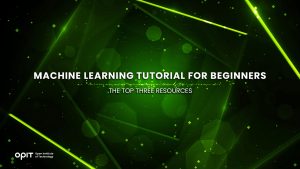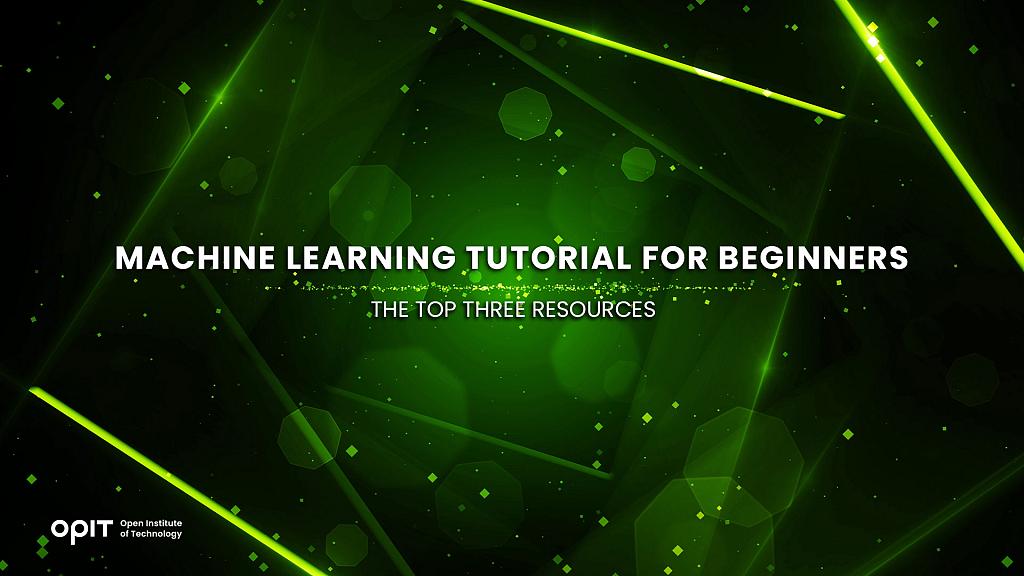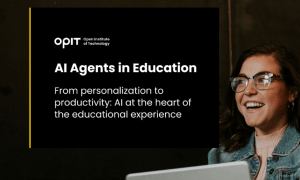

Technology transforms the world in so many ways. Ford’s introduction of the assembly line was essential to the vehicle manufacturing process. The introduction of the internet changed how we communicate, do business, and interact with the world. And in machine learning, we have an emerging technology that transforms how we use computers to complete complex tasks.
Think of machine learning models as “brains” that machines use to actively learn. No longer constrained by rules laid out in their programming, machines have the ability to develop an understanding of new concepts and deliver analysis in ways they never could before. And as a prospective machine learning student, you can become the person who creates the “brains” that modern machines use now and in the future.
But you need a good starting point before you can do any of that. This article covers three of the best machine learning tutorials for beginners who want to get their feet wet while building foundational knowledge that serves them in more specialized courses.
Factors to Consider When Choosing a Machine Learning Tutorial
A machine learning beginner can’t expect to jump straight into a course that delves into neural networking and deep learning and have any idea what they’re doing. They need to learn to crawl before they can walk, making the following factors crucial to consider when choosing a machine learning tutorial for beginners.
- Content quality. You wouldn’t use cheap plastic parts to build an airplane, just like you can’t rely on poor-quality course content to get you started with machine learning. Always look for reviews of a tutorial before engaging, in addition to checking the credentials of the provider to ensure they deliver relevant content that aligns with your career goals.
- Instructor expertise. Sticking with our airplane analogy, imagine being taught how to pilot a plane by somebody who’s never actually flown. It simply wouldn’t work. The same goes for a machine learning tutorial, as you need to see evidence that your instructor does more than parrot information that you can find elsewhere. Look for real-world experience and accreditation from recognized authorities.
- Course structure and pacing. As nice as it would be to have an infinite amount of free time to dedicate to learning, that isn’t a reality for anybody. You have work, life, family, and possibly other study commitments to keep on top of, and your machine learning tutorial has to fit around all of it.
- Practical and real-world examples. Theoretical knowledge can only take you so far. You need to know how to apply what you’ve learned, which is why a good tutorial should have practical elements that test your knowledge. Think of it like driving a car. You can read pages upon pages of material on how to drive properly but you won’t be able to get on the road until you’ve spent time learning behind the wheel.
- Community support. Machine learning is a complex subject and it’s natural to feel a little lost with the materials in many tutorials. A strong community gives you a resource base to lean into, in addition to exposing you to peers (and experienced tech-heads) who can help you along or point you in the right career direction.
Top Three Machine Learning Tutorials for Beginners
Now you know what to look for in a machine learning tutorial for beginners, you’re ready to start searching for a course. But if you want to take a shortcut and jump straight into learning, these three courses are superb starting points.
Tutorial 1 – Intro to Machine Learning (Kaggle)
Offered at no cost, Intro to Machine Learning is a three-hour self-paced course that allows you to learn as and when you feel like learning. All of which is helped by Kaggle’s clever save system. You can use it to save your progress and jump back into your learning whenever you’re ready. The course has seven lessons, the first of which offers an introduction to machine learning as a concept. Whereas the other six dig into more complex topics and come with an exercise for you to complete.
Those little exercises are the tutorial’s biggest plus point. They force you to apply what you’ve learned before you can move on to the next lesson. The course also has a dedicated community (led by tutorial creator Dan Becker) that can help you if you get stuck. You even get a certificate for completing the tutorial, though this certificate isn’t as prestigious as one that comes from an organization like Google or IBM.
On the downside, the course isn’t a complete beginner’s course. You’ll need a solid understanding of Python before you get started. Those new to coding should look for Python courses first or they’ll feel lost when the tutorial starts throwing out terminology and programming libraries that they need to use.
Ideal for students with experience in Python who want to apply the programming language to machine learning models.
Tutorial 2 – What Is Machine Learning? (Udemy)
You can’t build a house without any bricks and you can’t build a machine learning model before you understand the different types of learning that underpin that model. Those different types of learning are what the What is Machine Learning tutorial covers. You’ll get to grips with supervised, unsupervised, and reinforcement learning, which are the three core learning types a machine can use to feed its “brain.”
The course introduces you to real-world problems and helps you to see which type of machine learning is best suited to solving those problems. It’s delivered via online videos, totaling just under two hours of teaching, and includes demonstrations in Python to show you how each type of learning is applied to real-world models. All the resources used for the tutorial are available on a GitHub page (which also gives you access to a strong online community) and the tutorial is delivered by an instructor with over 27 years of experience in the field.
It’s not the perfect course, by any means, as it focuses primarily on learning types without digging much deeper. Those looking for a more in-depth understanding of the algorithms used in machine learning won’t find it here, though they will build foundational knowledge that helps them to better understand those algorithms once they encounter them. As an Udemy course, it’s free to take but requires a subscription to the service if you want a certificate and the ability to communicate directly with the course provider.
Ideal for students who want to learn about the different types of machine learning and how to use Python to apply them.
Tutorial 3 – Machine Learning Tutorial (Geeksforgeeks)
As the most in-depth machine learning tutorial for beginners, the Geeksforgeeks offering covers almost all of the theory you could ever hope to learn. It runs the gamut from a basic introduction to machine learning through to advanced concepts, such as natural language processing and neural networks. And it’s all presented via a single web page that acts like a hub that links you to many other pages, allowing you to tailor your learning experience based on what aligns best with your goals.
The sheer volume of content on offer is the tutorial’s biggest advantage, with dedicated learners able to take themselves from complete machine learning newbies to accomplished experts if they complete everything. There’s also a handy discussion board that puts you in touch with others taking the course. Plus, the “Practice” section of the tutorial includes real-world problems, including a “Problem of the Day” that you can use to test different skills.
However, some students may find the way the material is presented to be a little disorganized and it’s easy to lose track of where you are among the sea of materials. The lack of testing (barring the two or three projects in the “Practice” section) may also rankle with those who want to be able to track their progress easily.
Ideal for self-paced learners who want to be able to pick and choose what they learn and when they learn it.
Additional Resources for Learning Machine Learning
Beyond tutorials, there are tons of additional resources you can use to supplement your learning. These resources are essential for continuing your education because machine learning is an evolving concept that changes constantly.
- Books. Machine learning books are great for digging deeper into the theory you learn via a tutorial, though they come with the downside of offering no practical examples or ways to interact with authors.
- YouTube channels. YouTube videos are ideal for visual learners and they tend to offer a free way to build on what you learn in a tutorial. Examples of great channels to check out include Sentdex and DeepLearningAI, with both channels covering emerging trends in the field alongside lectures and tutorials.
- Blogs and websites. Blogs come with the advantage of the communities that sprout up around them, which you can rely on to build connections and further your knowledge. Of course, there’s the information shared in the blogs, too, though you must check the writer’s credentials before digging too deep into their content.
Master a Machine Learning Tutorial for Beginners Before Moving On
A machine learning tutorial for beginners can give you a solid base in the fundamentals of an extremely complex subject. With that base established, you can build up by taking other courses and tutorials that focus on more specialized aspects of machine learning. Without the base, you’ll find the learning experience much harder. Think of it like building a house – you can’t lay any bricks until you have a foundation in place.
The three tutorials highlighted here give you the base you need (and more besides), but it’s continued study that’s the key to success for machine learning students. Once you’ve completed a tutorial, look for books, blogs, YouTube channels, and other courses that help you keep your knowledge up-to-date and relevant in an ever-evolving subject.
Related posts

Source:
- Times of Malta, published on September 18th, 2025
4 min read
The gathering brought together academics and technology leaders from prominent European Institutions, such as Instituto de Empresa (IE University), OPIT itself and the Royal College of Arts, to explore how artificial intelligence is reshaping the university experience.
The OPIT AI Copilot has been trained on the institute’s complete academic archive, a collection created over the past three years that includes 131 courses, more than 3,500 hours of recorded lectures, 7,500 study resources, 320 certified assessments, and thousands of exercises and original learning documents.
Unlike generic AI tools, the Copilot is deeply integrated with OPIT’s learning management system, allowing it to track each student’s progress and provide tailored support.
This integration means the assistant can reference relevant sources within the learning environment, adapt to the student’s stage of study, and ensure that unreleased course content remains inaccessible.
A mobile app is also scheduled for release this autumn, that will allow students to download exercise and access other tools.
During examinations, the Copilot automatically switches to what the institute calls an “anti-cheating mode”, restricting itself to general research support rather than providing direct answers.
For OPIT’s international community of 500 students from nearly 100 countries, many of whom balance studies with full-time work, the ability to access personalised assistance at any time of day is a key advantage.
“Eighty-five per cent of students are already using large language models in some way to study,” said OPIT founder and director Riccardo Ocleppo. “We wanted to go further by creating a solution tailored to our own community, reflecting the real experiences of remote learners and working professionals.”
Tool aims to cut correction time by 30%
The Copilot will also reduce administrative burdens for faculty. It can help grade assignments, generate new educational materials, and create rubrics that allow teachers to cut correction time by as much as 30 per cent.
According to OPIT, this will free up staff to dedicate more time to teaching and direct student engagement.
At the Milan event, Rector Francesco Profumo underlined the broader implications of AI in higher education. “We are in the midst of a deep transformation, where AI is no longer just a tool: it is an environment that radically changes how we learn, teach, and create,” he said.
“But it is not a shortcut. It is a cultural, ethical, and pedagogical challenge, and to meet it we must have the courage to rethink traditional models and build bridges between human and artificial intelligence.”
OPIT was joined on stage by representatives from other leading institutions, including Danielle Barrios O’Neill of the Royal College of Art, who spoke about the role of AI in art and creativity, and Francisco Machin of IE University, who discussed applications in business and management education.
OPIT student Asya Mantovani, also employed at a leading technology and consulting firm in Italy, gave a first-hand account of balancing professional life with online study.
The assistant has been in development for the past eight months, involving a team of OPIT professors, researchers, and engineers.
Ocleppo stressed that OPIT intends to make its AI innovations available beyond its own institution. “We want to put technology at the service of higher education,” he said.
“Our goal is to develop solutions not only for our own students, but also to share with global institutions eager to innovate the learning experience in a future that is approaching very quickly.”

From personalization to productivity: AI at the heart of the educational experience.
Click this link to read and download the e-book.
At its core, teaching is a simple endeavour. The experienced and learned pass on their knowledge and wisdom to new generations. Nothing has changed in that regard. What has changed is how new technologies emerge to facilitate that passing on of knowledge. The printing press, computers, the internet – all have transformed how educators teach and how students learn.
Artificial intelligence (AI) is the next game-changer in the educational space.
Specifically, AI agents have emerged as tools that utilize all of AI’s core strengths, such as data gathering and analysis, pattern identification, and information condensing. Those strengths have been refined, first into simple chatbots capable of providing answers, and now into agents capable of adapting how they learn and adjusting to the environment in which they’re placed. This adaptability, in particular, makes AI agents vital in the educational realm.
The reasons why are simple. AI agents can collect, analyse, and condense massive amounts of educational material across multiple subject areas. More importantly, they can deliver that information to students while observing how the students engage with the material presented. Those observations open the door for tweaks. An AI agent learns alongside their student. Only, the agent’s learning focuses on how it can adapt its delivery to account for a student’s strengths, weaknesses, interests, and existing knowledge.
Think of an AI agent like having a tutor – one who eschews set lesson plans in favour of an adaptive approach designed and tweaked constantly for each specific student.
In this eBook, the Open Institute of Technology (OPIT) will take you on a journey through the world of AI agents as they pertain to education. You will learn what these agents are, how they work, and what they’re capable of achieving in the educational sector. We also explore best practices and key approaches, focusing on how educators can use AI agents to the benefit of their students. Finally, we will discuss other AI tools that both complement and enhance an AI agent’s capabilities, ensuring you deliver the best possible educational experience to your students.
Have questions?
Visit our FAQ page or get in touch with us!
Write us at +39 335 576 0263
Get in touch at hello@opit.com
Talk to one of our Study Advisors
We are international
We can speak in:
